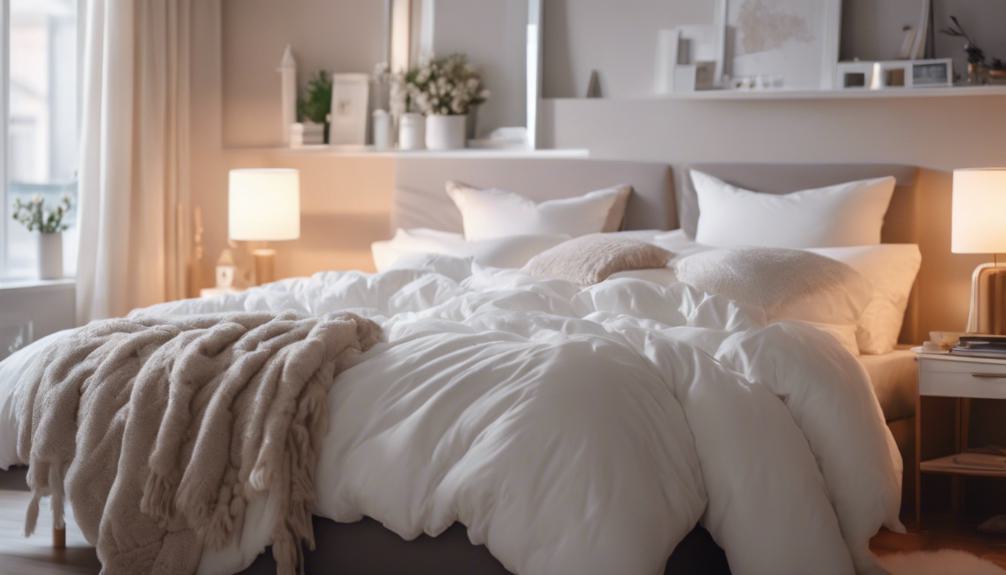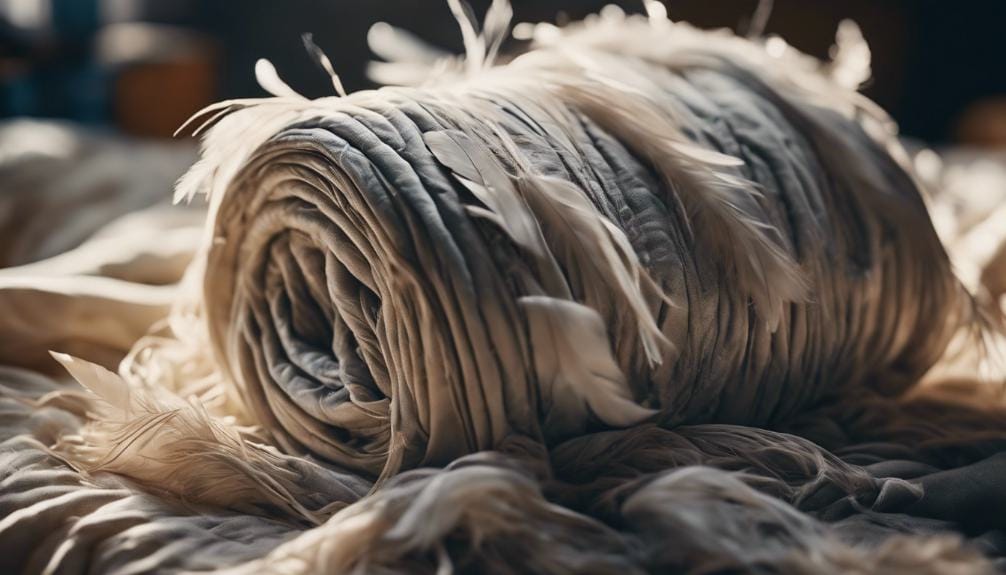What Is a Comforter? Everything You Need to Know Explained
Ever wondered what a comforter really is? It’s a big, cozy fabric pouch filled with wool, silk, cotton, or polyester for warmth and comfort while you sleep. These pouches are quilted to keep the filling in place, guaranteeing warmth and protection. They come in various sizes and designs, perfect for pairing with flat sheets or thin blankets. Comforters vs. duvets? Fill power determines warmth and loftiness, with comforters ranging from 400 to 800. Choosing the right size guarantees a cozy sleep environment. Learn more about comforters to make your bed even cozier!
Definition of a Comforter
A comforter is a large fabric pouch filled with soft materials like wool, silk, cotton, or polyester, designed to provide warmth and comfort during sleep. These beddings are quilted to keep the filling in place, offering warmth and protection.
Available in various sizes and designs, comforters are versatile top covers that can be used with flat sheets or thin blankets, providing both style and functionality in the bedroom.
Comforter Vs Duvet: Key Differences
When comparing comforters and duvets, it’s crucial to look at fill power, material, texture, and maintenance tips. Fill power determines the warmth and loftiness of your bedding, while material and texture affect comfort and durability.
Grasping these key differences will help you choose the perfect option for your sleeping needs.
Fill Power Comparison
Comparing the fill power in comforters and duvets reveals essential differences in warmth and insulation levels. Comforters typically range from 400 to 800 fill power, offering quality insulation.
In contrast, duvets boast higher fill power, ranging from 600 to 900, providing superior warmth and fluffiness. Higher fill power signifies more down clusters, ensuring better insulation.
Grasping these differences helps in selecting bedding tailored to your warmth and comfort preferences.
Material & Texture
To distinguish between comforters and duvets based on their material and texture, consider their construction and design differences.
Comforters often feature vibrant styles and are fluffier, providing ample warmth. Comforter fillings can vary from cotton, polyester, to luxurious silk, ensuring different warmth levels and textures to suit your preferences.
On the other hand, duvets come with washable covers for easy maintenance and clean designs.
Maintenance Tips
Understanding the key maintenance distinctions between comforters and duvets is essential for ensuring their longevity and peak performance.
Comforters are often machine washable, simplifying cleaning. Duvets feature a removable cover that can be washed separately, making maintenance easier.
Comforters are a single piece of bedding, while duvets consist of an insert that fits into a cover. Proper maintenance of both comforters and duvets is vital for peak performance and durability.
Comforter Sizes and Chart
Finding the right comforter size can be an important factor in achieving a cozy sleep environment. Comforter sizes like king, queen, full, and twin vary, making it essential to choose the right one for your bed size.
A comforter sizes chart can help you select the perfect fit. Materials used for fillings range from cotton to down, silk, and polyester, ensuring warmth is evenly distributed for a comfortable sleep experience.
Pros of Using a Comforter

When it comes to using a comforter, you’ll find that they provide exceptional warmth during the cold winter months.
Additionally, comforters are easy to clean and require less maintenance than other bedding options.
With a wide variety of designs to choose from, comforters can add a touch of style to your bedroom while keeping you cozy.
Warmth in Winter
During the chilly winter nights, snuggling under a quality comforter can provide exceptional warmth and insulation, ensuring a cozy and comfortable sleep environment.
The filling of a comforter, such as down feathers, offers excellent insulating properties that trap heat effectively. This helps in maintaining body heat and creates a snug atmosphere, making it perfect for the colder months when you need that extra warmth for a good night’s rest.
Easy to Clean
Keeping your comforter clean is a breeze with its machine washable feature, ensuring convenience and maintaining hygiene effortlessly.
For down comforters, dry cleaning may be necessary, while other materials can be washed at home. To preserve quality, use gentle detergent, cold water, and opt for low heat drying.
Additionally, comforters with removable covers offer added cleanliness, and regular washing every 4 to 6 months helps prolong their lifespan.
Variety of Designs
Explore the exciting array of designs and patterns available with comforters, adding a touch of style and personality to your bedroom decor effortlessly.
Comforters come in various colors, textures, and styles, from classic solid hues to intricate patterns. Some feature reversible designs for added versatility.
With themed, seasonal, and artistic options, comforters can serve as a focal point in your bedroom, allowing you to express your unique taste and preferences.
Cons of Using a Comforter

Using a comforter may pose certain drawbacks that should be considered before making a purchase.
- Not machine washable, requiring special care.
- Flattening over time, affecting warmth.
- Delicate handling and maintenance needed, especially for down-filled comforters.
- Stains or damage may require replacement, unlike duvets with separate covers.
Be mindful of heat retention and potential discomfort for some sleepers.
How to Choose the Right Comforter
When choosing a comforter, prioritize durability and softness by considering a thread count ranging from 300 to 500. Look for natural materials like cotton for breathability in the shell. Select a filling such as cotton or down alternative based on your local climate. Confirm the comforter is the right size, weight, and thickness for your preferences. A duvet cover can also help protect your comforter and add style to your bedding.
| Category | Key Consideration | Tips |
|---|---|---|
| Fill Power | Natural Materials | Choose cotton for breathability. |
| Synthetic Fibers | Comforter Filling | Opt for down alternative for warmth. |
| Thread Count | Durability & Softness | Select 300-500 for a soft cover. |
| Warmth | Weight & Thickness | Choose based on personal preference. |
Maintenance Tips for Comforters

To maintain the cleanliness and freshness of your comforter, it’s recommended to wash it every 4 to 6 months with proper protection. Here are some maintenance tips for your comforter:
- Use gentle detergent and cold water for washing.
- Dry on a low heat setting with tennis balls.
- Consider a laundromat for larger comforters.
- Store in a breathable bag for dust protection.
Popular Comforter Brands and Options
Popular comforter brands like Brooklinen and APSMILE offer a variety of options to suit your size, warmth level, and style preferences. These brands provide comforters in different sizes such as twin, queen, king, and California king.
You can choose from various warmth levels like lightweight, medium, or heavyweight for personalized comfort. Additionally, some brands offer extra features like hypoallergenic materials, temperature regulation, and a wide range of colors and patterns to match your bedroom decor.
Frequently Asked Questions
What Are Comforters Explained?
Comforters are cozy bedding pieces filled with materials like cotton, wool, or polyester for warmth. They come in various colors and patterns to suit your style. Comforters are flatter than duvets but still keep you snug at night.
What Is the Function of a Comforter?
A comforter’s function is to provide warmth and comfort during sleep by evenly distributing heat. It acts as a top sheet in bedding sets, adding insulation with its fluffy layers. Perfect for colder climates!
Why Is a Comforter Important?
A comforter is important for providing warmth and comfort during sleep. It adds insulation to your bedding set, ensuring a cozy environment. Filled with materials like cotton or down, it’s essential for a good night’s rest.
What Does a Comforter Set Include?
In a comforter set, you’ll find a cozy comforter, pillow shams, and decorative pillows. Some sets may include extra goodies like bed skirts or sheets. They come in various sizes and carefully curated designs to match your style.
Conclusion
To sum up, a comforter is a cozy bedding essential that adds warmth and style to your bedroom.
Remember, when choosing a comforter, consider factors such as size, material, and maintenance needs.
Whether you prefer a lightweight option for summer or a thick one for winter, there are plenty of comforter brands and styles to choose from.
With proper care and selection, a comforter can enhance your sleeping experience and keep you comfortable all year round.
